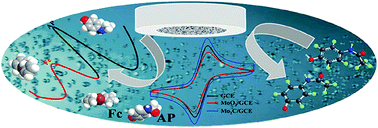Ratiometric electrochemical sensing based on Mo2C for detection of acetaminophen†
Abstract
In this work, MoO2 nanoparticles were synthesized and annealed to form Mo2C nanoparticles. This is the first report of a ratiometric electrochemical sensor (R-ECS) for the detection of acetaminophen (AP), in which Mo2C is used as the sensing agent and ferrocene (FC) is used as an internal reference. FC (100 μM) is added directly to the electrolyte solution for convenient operation. The synthesized materials were fully characterized with respect to composition, morphology and electrochemical performance. The oxidation peak potentials of FC (0.196 V) and AP (0.364 V) can be completely separated by the Mo2C modified glassy carbon electrode, and their ratiometric signals are used for the quantification of AP. It was found that the oxidation peak currents of AP at separated potentials on Mo2C/GCE are linear with concentration in the range of 0.5–600 μM, and the detection limit is 0.029 μM (S/N = 3). Mo2C/GCE exhibited decent repeatability, reproducibility, stability, and selectivity. The sensor was then applied to measure AP in tap water and river water.

- This article is part of the themed collection: Analyst Recent HOT articles


 Please wait while we load your content...
Please wait while we load your content...